TUDOR RELATIONSHIPS of Catherine Parr
Jump to navigation
Jump to search
| Under Construction Catherine Parr's Relationships 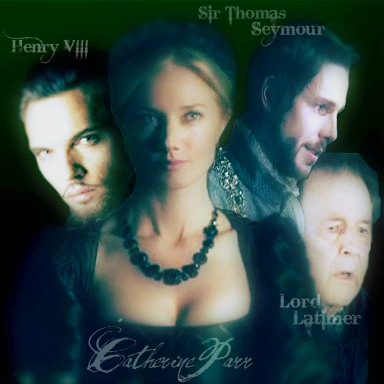 Catherine Parr is to this day still the most married Queen of England and Ireland with four marriages. A more in depth look at her husbands is discussed here. Her first marriage to the son of Lord Burgh of Gainsborough, Sir Edward Burgh "Borough" was short lived. Her marriage to an English peer elevated Catherine and she became the first female in her family since her great-aunt to marry into the peerage. Almost twice her age, Sir John Neville was her father's second cousin. The marriage was a strained by the constant complications which came about due to the Pilgrimage of Grace; Catherine's husband was dragged off in the middle of the night leaving her alone with her step-children to fend for herself. When her husband finally returned the family lived in fear and Neville was in a constant state of paranoia. In 1543, Lord Latimer died leaving Catherine a rich widow. Catherine decided to stay in London and make the most of her ties to court. Using her mother's relationship with Queen Katherine of Aragon she was appointed to be a part of Lady Mary's household. It was there that she was pursued by the King. Months later after a grueling decision Catherine married the King at Hampton Court. |
Click EasyEdit to add to this page!
(Don't see the EasyEdit button above? <a href="../#signin" target="_self">Sign in</a> or <a href="../accountnew" target="_self">Sign up</a>.)
| Sir Edward "Burgh" Borough (m. 1529-1533) |
| In Agnes Strickland's book the 'Queens of England', Catherine is described as a nurse, her first husband is incorrect, and she has her born at Kendal Castle. Because of this Queen Catherine has been seen in a certain light for over a century. Even in 2004, when David Starkey had published his "Six Wives of Henry VIII" with the correct information about Catherine -- it never changed on the internet and unless you picked up a book about Catherine everything we thought was true online was incorrect and still is on many sites. Wikipedia wasn't even updated about the fact that Catherine did not marry the elderly Edward Borough until recently. Why did it take so long? Perhaps no one was extremely interested in Catherine until the show "The Tudors" emerged showing some of Catherine's story. Catherine was thought to have married the elderly Edward Burgh, 2nd Baron Burgh in 1529, at the age of seventeen, but the 2nd Baron died in August 1528.[1][9] It is has now been revealed through the recent research of documents and the will of Catherine's mother by biographers Susan James, Linda Porter, Alison Weir, and David Starkey that she married the 2nd Baron's grandson, who shared his first name. Sir Edward Borough was the eldest son of the 2nd Baron's eldest son, Sir Thomas Borough, who would become the "3rd Baron" in name, but summoned to Parliament under a new writ as the 1st Baron Borough after his father's death. In Maud [Green] Parr's will, dated May 1529, she mentioned Sir Thomas, father of Edward, saying 'I am indebted to Sir Thomas Borough, knight, for the marriage of my daughter'. At 1529, again, the elderly Edward was dead. At the time of his son's marriage, Thomas, was thirty-five which would have made Edward around Catherine's age.[1] Edward was in his twenties and may have been in poor health. He served as a feoffee for Thomas Kiddell and as a justice of the peace. His father, Sir Thomas, Anne Boleyn's chamberlain, also secured a joint patent in survivorship with his son for the office of steward of the manor of the soke of Kirton in Lindsey. The younger Sir Edward Borough died in the spring of 1533 never fulfilling the title of Lord Borough of Gainsborough. The title was passed to his younger brother, William, who would become the 2nd Baron.[1][7] Sources: [1] Linda Porter. Katherine, the Queen. Macmillan. 2010. [7] James, Susan E. Kateryn Parr: The Making of a Queen. Aldershot, England: Ashgate Publishing Ltd. 1999. pg. 60-63. [9] Charles Mosley, editor, Burke's Peerage, Baronetage & Knightage, 107th edition, 3 volumes (Wilmington, Delaware, U.S.A.: Burke's Peerage (Genealogical Books) Ltd, 2003), volume 1, page 587. Maud Parr looked to the Northern families for her daughter's marriage after the deal with Lord Scrope of Bolton did not play out. In the lands of Sheriff Hutton, where her son William had once resided in the Henry Fitzroy, Duke of Richmond's household, Maud found the royal surveyor of the castle, manor and lands, Sir Thomas Borough of Gainsborough, who was a distant kinsman of her husband, Sir Thomas Parr.[1] The Boroughs of Gainsborough in Lincolnshire were and old and well-established gentry family. Sir Thomas' grandfather, the 1st Baron had been an outstanding Yorkist in the reign of King Edward IV in the neighborhood of fanatical Lancastrians. He was a tough-minded and hard-handed individual who was given the Order of the Garter in 1496 by King Henry VII proving his ability to change and adapt with the constant royal change. Sir Thomas' father, Sir Edward Borough, who became the 2nd Baron in name only, in 1496, was not so fortunate. Sir Edward, only a few years after succeeding to the barony, was declared a lunatic and was kept under restraint in his own home, Gainsborough Old Hall. After his incarceration, Sir Thomas, his son, took over as head of the family.[2][2.1] Both Sir Thomas and his first wife Agnes Tyrwhit were kin to the Parrs and marriage into the family was seen as a suitable solution. Sir Thomas' eldest son, Edward, was in his early twenties and although almost nothing is known about his character, it appears that his health kept him in a frail condition. Whether his health was frail or perhaps he inherited the bad seeds of his grandfather's lunacy is uncertain. There were also rumors that Edward may have been homosexual. Whatever the ordeal, Edward was competent enough for his father to allow him the duties and responsibilities of part of his inheritance -- he served as both a feofee and a justice of peace.[3] For centuries, historians like Agnes Strickland and antiquarians alike have confused the grandfather, Lord Borough -- with the grandson -- Sir Edward -- throwing the Scrope-Parr marriage negotiations into the mix for good measure. The story of twelve year old Catherine being sent away to marry an aged lunatic was a wonderful story filled with drama -- but none the less was a myth that can now be laid to rest. The truth although is not quite so lurid and had its own moments of drama. 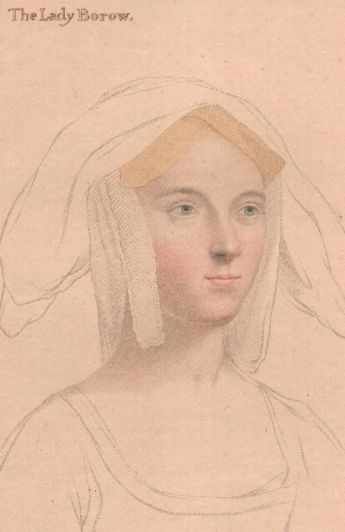 Most likely in the Spring of 1529,[4] Catherine, now aged sixteen, set out for Lincolnshire to become the bride of Sir Edward Borough taking with her a wedding gift from her mother of two gold bracelets and a rosary. This was Catherine's first venture north and given her closeness to her mother and her family it must have made her somewhat homesick. Most likely in the Spring of 1529,[4] Catherine, now aged sixteen, set out for Lincolnshire to become the bride of Sir Edward Borough taking with her a wedding gift from her mother of two gold bracelets and a rosary. This was Catherine's first venture north and given her closeness to her mother and her family it must have made her somewhat homesick.Life at Old Gainsborough Hall with an unfamiliar husband and an over-bearing father-in-law given to violent rages, and the memories of the recently deceased lunatic in the attic must have frightened Catherine. Catherine's new father-in-law ruled his family with an iron hand requiring absolute obedience. Some time after her marriage, Catherine's father-in-law had another daughter-in-law, Elizabeth Owen, thrown out of the household and her children with his younger son Thomas declared bastards. Catherine's husband lived in fear of his own father.[5] In May 1533, at the celebrations for the coronation of Anne Boleyn, Catherine's father-in-law was severely rebuked for 'ripping Queen Katherine of Aragon's [coat of] arms off her barge and for seizing the barge.' Having been appointed Boleyn's Lord chamberlain, he maintained a high profile and rode in her barge as she was received at the Tower on her coronation day. Appearing in the procession he wore a surcoat and mantle of white cloth of tissue and ermine as he held the middle of Anne Boleyn's coronation train.[6] The copy of a sketch by Hans Holbein of the "Lady Borow" (right) is thought by some to be Catherine. Catherine's father-in-law, Sir Thomas Borough, 1st Baron, during the time of Catherine's marriage to his son, Edward, commissioned a portrait by Holbein of his wife Agnes Tyrwhitt, the Lady Borough at the time. Lord Borough had to pull his connections and power at court to have this done, so perhaps this is not Catherine, but Agnes. (Porter, pg 55) Thomas Borough had an ambitious reform-minded chaplain with whom he discussed his opinions in the matter of religion with. The passion for the reformed religion in the household of the Borough's could have been where Catherine was first introduced to the new religion.[7] Yet Katherine's duty was not to discuss religion but to bear sons, which she did not do. Failure to do so may not have been all her fault. Having been raised in a liberal and enlightened household maintained by her mother -- Edward Borough's new bride was unused to the paternal tyranny of the household at Gainsborough. If Sir Thomas attempted to intimidate Catherine, he did not succeed. In fact, Sir Thomas came to find that Catherine was made of sterner stuff than his own sons! Another reason for the failure, which may have also put a strain on the marriage, could have been due to Catherine's marriage portion which had not yet been paid for. For in Maud [Green] Parr's will, written in 1529, she remarked 'I am indebted to Sir Thomas Borough, knight, for the marriage of my daughter'.[4] 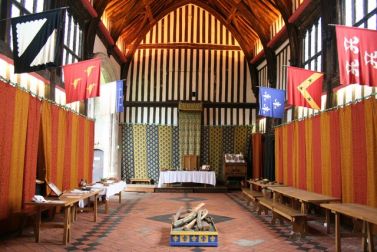 For a time, Catherine and Edward lived with Edward's family at Gainsborough Old Hall. If Catherine was homesick or unhappy, she had reason to be and wrote frequently to her mother for advice. Her mother would travel north in 1530 to see Catherine and it is most likely at her urging that the couple move out of the Old Hall after two years of marriage. Sir Thomas was a steward to the manor of the soke of Kirton-in-Lindsey, a small village about ten miles above Gainsborough. Thomas was persuaded to secure a joint patent in survivorship with his son. Catherine and Edward moved to Kirton-in-Lindsey. It was a modest residence, but mainly it was away from her in-laws and was a household in which she was the sole mistress. Instead of becoming the passive lady of the household, Catherine took control of her fortunes. If Catherine was ever pregnant by Sir Edward, which might have been possible when the idea of a separate household was discussed, then clearly none survived to full term, or certainly past infancy. The historical record is completely silent on this issue. If that was the case, although her immediate family would have known, it was never spoken of and Catherine never did either. But with the joy of escaping the Old Hall came the tragic news of her mother's death less than a year after she moved. For a time, Catherine and Edward lived with Edward's family at Gainsborough Old Hall. If Catherine was homesick or unhappy, she had reason to be and wrote frequently to her mother for advice. Her mother would travel north in 1530 to see Catherine and it is most likely at her urging that the couple move out of the Old Hall after two years of marriage. Sir Thomas was a steward to the manor of the soke of Kirton-in-Lindsey, a small village about ten miles above Gainsborough. Thomas was persuaded to secure a joint patent in survivorship with his son. Catherine and Edward moved to Kirton-in-Lindsey. It was a modest residence, but mainly it was away from her in-laws and was a household in which she was the sole mistress. Instead of becoming the passive lady of the household, Catherine took control of her fortunes. If Catherine was ever pregnant by Sir Edward, which might have been possible when the idea of a separate household was discussed, then clearly none survived to full term, or certainly past infancy. The historical record is completely silent on this issue. If that was the case, although her immediate family would have known, it was never spoken of and Catherine never did either. But with the joy of escaping the Old Hall came the tragic news of her mother's death less than a year after she moved."In learning, charity, and responsibility for the welfare of her family, Maud was the pattern from which Katherine constructed her own self-image." (James. pg 55) A year and a half after the death of her mother, Catherine's marriage to the fragile Edward came to an end. In 1532, Catherine's husband was named to the various commissions of peace that held session in the area, but by April of 1533, Edward Borough "Burgh" was dead. Unable to remain at Kirton-in Lindsey, which belonged to her father-in-law, Catherine's options were limited. Her in-laws showed no desire in having her move back into Gainsborough Old Hall or in even keeping her around. Sir Thomas turned over the income of two of his manors in Surrey and one in Kent as her dower and that was the end of it. With no children from her marriage to Edward, she no longer had ties to the Borough's and was most likely more than happy to be rid of them.[8] As a young widow barely out of her teens, Catherine found herself with little money, no home and no support system among her late husband's circle. Catherine found herself all alone with the question of what to do and where to go. Sources: Primary: James, Susan E. Kateryn Parr: The Making of a Queen. Aldershot, England: Ashgate Publishing Ltd. 1999. pg. 60-63. * Douglas Richardson, Kimball G. Everingham. Magna Carta ancestry: a study in colonial and medieval families, Genealogical Publishing Company, 2005. pg 838. [1] Letters and Papers, Foreign and Domestic, of the Reign of Henry VIII; I, i, no. 563 (10). [2] M.E. James, 'Obediance and Dissent in Henrician England: The Lincolnshire Rebellion, 1536', Past and Present, 48 (August 1970), 3-78. [2.1] Letters and Papers, Foreign and Domestic, of the Reign of Henry VIII; 2, i, no. 1363. [3] Letters and Papers, Foreign and Domestic, of the Reign of Henry VIII; 5, no. 1694, and II, no. 943 (7). [4] National Archives, London. PROB: 11/24; Image Reference 149/110. *The wording of Maud Parr's will implies that Katherine's marriage had only recently taken place and the making of the will itself may have been inspired by the recently concluded marriage of Lady Parr's eldest daughter. [5] Letters and Papers, Foreign and Domestic, of the Reign of Henry VIII. [6] Letters and Papers, Foreign and Domestic, of the Reign of Henry VIII; 6, p. 241. [7] D. Willen: 1989, 148-152. [8] Letters and Papers, Foreign and Domestic, of the Reign of Henry VIII; 12, ii, no. 187(6). |
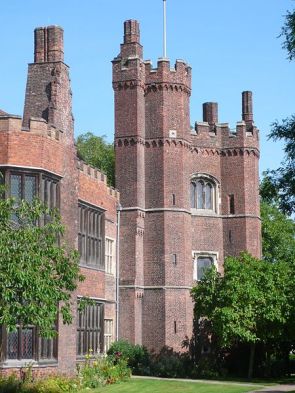 Gainsborough Old Hall, Lincolnshire UK Gainsborough Old Hall, Lincolnshire UKThe Baron Burgh's were rich, flamboyant and powerful people. Gainsborough Old Hall was not only their home, but also a demonstration of their wealth and importance. Sir Thomas, great-grandfather of Sir Edward, was a great benefactor to Newark Church and also the founder of the Chantry and Alms House at Gainsborough. In 1470, the manor was attacked by Sir Robert Welles over a clash about lands, status, and honour, but it was not severely damaged. It was in 1484, that Sir Thomas entertained King Richard III in his hall.[1] King Henry VIII also visited Gainsborough twice; once in 1509 and again in 1541 with the doomed Queen Katherine Howard Source: [1]John Julius Norwich. Treasures of Britain; the architectural, cultural, historical and natural heritage of Britain. W. W. Norton & Company, 2002. pg 262. |
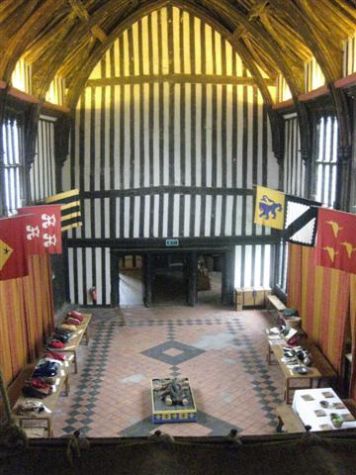 | 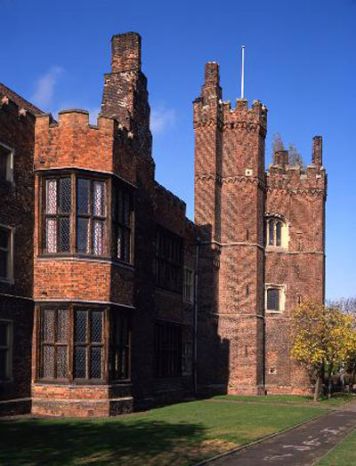 |
| | |
| Sir John Neville, Lord Latimer (m. 1534-1543) |
| In the year of 1533, Catherine is thought to have spent her widowhood with her cousins, the Strickland family at Sizergh Castle in Westmorland (now Cumbria). In the summer of 1534 she married John Neville, 3rd Baron Latymer, of Snape, North Yorkshire. At age 40, Lord Latimer was twice Catherine's age. Latimer was her father's second cousin, a twice-widowed descendant of George Neville, 1st Baron Latimer; Warwick, the 'Kingmaker's', 'idiot uncle'. From his first marriage to Dorothy de Vere, sister of the John de Vere, Earl of Oxford, he had two children, John and Margaret. Neville was one of fifteen children born to Richard Neville, Lord Latimer and Anne Stafford, daughter of Sir Humphrey Stafford. Latimer's branch of the Neville family was in line for the title of Earl of Warwick and because of this, Lord Latimer, dealt with quite a bit of sibling rivalry. Legal actions were taken by his younger brothers and Latimer, at the time of his marriage to Catherine, was having financial difficulties. But as Lady Latimer, Catherine now had a home of her own, a husband with a position and influence in the north, a ready-made family, and a title. Catherine would be the only female Parr, apart from her great-aunt, Mabel, to marry into the peerage. From the beginning of the marriage, Catherine, tried to be a good wife. Her affection for her husband would grow deep enough to cherish a remembrance of him, his New Testament with his name inscribed inside, which she kept until her death. Catherine would also prove to be a good step-mother to her step-children; a trait which she would again show after her marriage to the King. Her "teenage" step-son, John, proved to be difficult. There is some indication that Margaret, his sister, was their father's favorite. Never the less, Catherine would continue a relationship with the two after her marriage to King Henry, bringing Margaret to court as her maid-in-waiting and securing a position for John's wife in her household.[1] Latimer was a supporter of the old religion and bitterly opposed the king's divorce and remarriage and it's religious ramifications. In 1546, within two weeks of the riot in Louth, a mob appeared before the Latimer's home threatening violence if Lord Latimer did not join their cause. Catherine watched as her husband was dragged away by the rebels. As prisoner of the rebels, conflicting stories of which side Latimer was truly on began to reach Cromwell and the King in London. The rebellion in Yorkshire put him in a terrible dilemma. If he was found guilty of any kind of treason his estates would be forfeited leaving Catherine and her step-children penniless. The King himself, wrote to the Duke of Norfolk pressing him to make sure Latimer would 'condemn that villain Aske and submit [himself] to our clemency'.[2] Latimer was more than happy to comply. Both Catherine's brother, William Parr and uncle, William, 1st Baron Parr of Horton fought with the Duke of Norfolk and the Duke of Suffolk against the rebellion. It is to most likely to Catherine's credit that Lord Latimer survived; both her brother and uncle probably intervened at one point and saved Lord Latimer's life.[1] From the months of October 1536 and April 1537 Lady Latimer lived alone in fear with her step-children, struggling to survive. It is probable that in these uncertain times that Catherine's strong reaction against the rebellion strengthened her adherence to the reformed church. In January 1537, Catherine and her step-children were held hostage at Snape Castle during the uprising of the North. The rebels ransacked the house and sent word to Lord Latimer, who was returning from London, that if he did not return immediately they would kill his family. When Lord Latimer returned to the castle he somehow talked the rebels into releasing his family and leaving, but the aftermath to follow with Lord Latimer would prove to be taxing on the whole family.[1] The family would later move south after the executions of the rebels which pleased Cromwell and the King. Although now charges were found, Latimer's reputation which reflected upon Catherine, was tarnished for the rest of his life. He spent the last seven years of his life blackmailed by Cromwell. Catherine would spend much of her time in the south during the years of 1537-42. Her husband was called away frequently to do the biding of Cromwell and the King and be present during Parliament. With Cromwell's fall in 1540, the Latimer's reclaimed some dignity and as Lord Latimer attended Parliament in 1542 he and Catherine spent time in London that winter. Her brother, William and sister, Anne had been present at court. Anne entered court service in 1531 as maid-in-waiting to Henry's queens. It was here that she made acquaintances and met her future fourth husband Sir Thomas Seymour. The atmosphere of the court was much different from the rural and parochial estates. It was at court that Catherine could find the latest trends, not only in religious matters, but in frivolous matters such as fashion and jewellery which she loved.[1] By the winter of 1542, Lord Latimer's health had broken down after a grueling life of what some would call 'political madness'. Catherine spent the winter of 1542-1543 nursing her husband. John Neville, Lord Latimer, died in 1543. In Lord Latimer's will, Catherine was named guardian of his daughter, Margaret, and was put in charge of Lord Latimer's affairs which were to be given over to his daughter at the age of her majority. Latimer left Catherine Stowe Manor and other properties. He also bequeathed money for supporting his daughter and in the case that his daughter did not marry within five years, Catherine, was to take £30 per annum out of the income to support her step-daughter. Catherine was left a rich widow faced with the possibility of having to return north after Lord Latimer's death.[1] Using her late mother's relationship with Henry's first queen Catherine of Aragon, Catherine took the opportunity to renew her friendship with Lady Mary. By 16 February 1543, Catherine had established herself with Mary and was now part of her household. References:
|
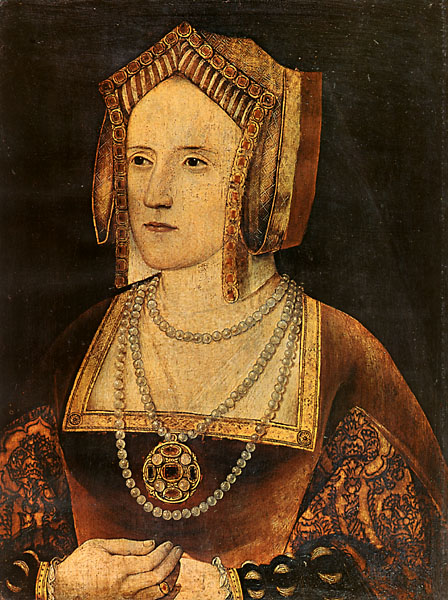 Portrait painted most likely during her time as Lady Latimer |
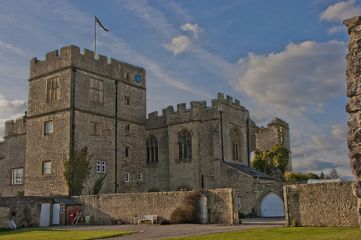 | 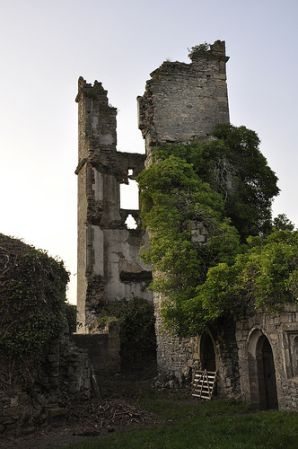 |
| | |
| King Henry VIII (m. 1543-1547) |
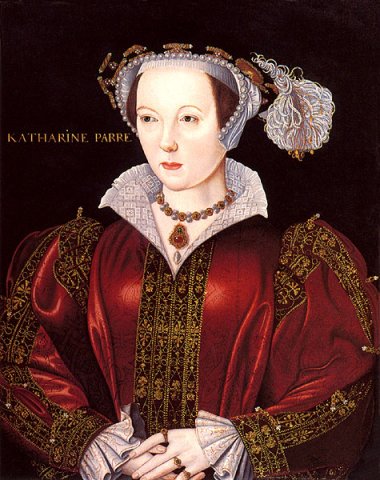 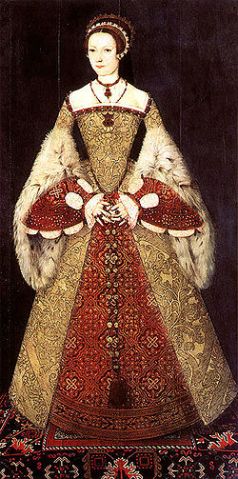 Catherine as Queen of England and Ireland |
| | |
| | |
| Sir Thomas Seymour (married 1547-1548) |
| |
| | |
| | |
| |
| |
| | |
| | |